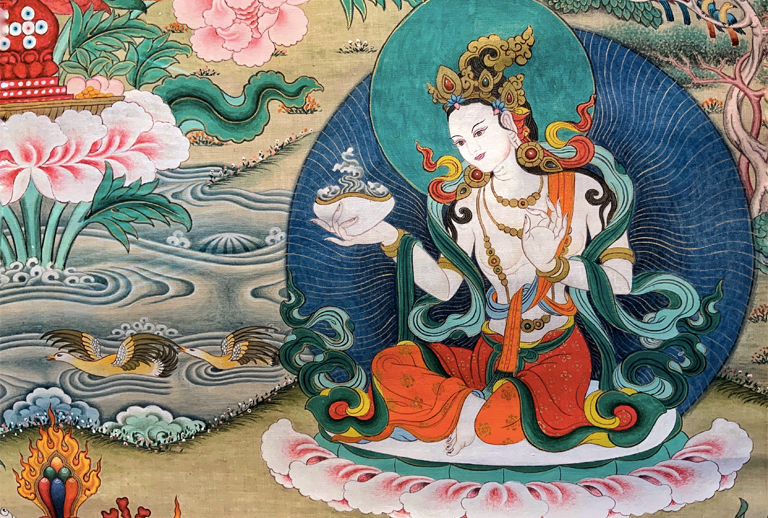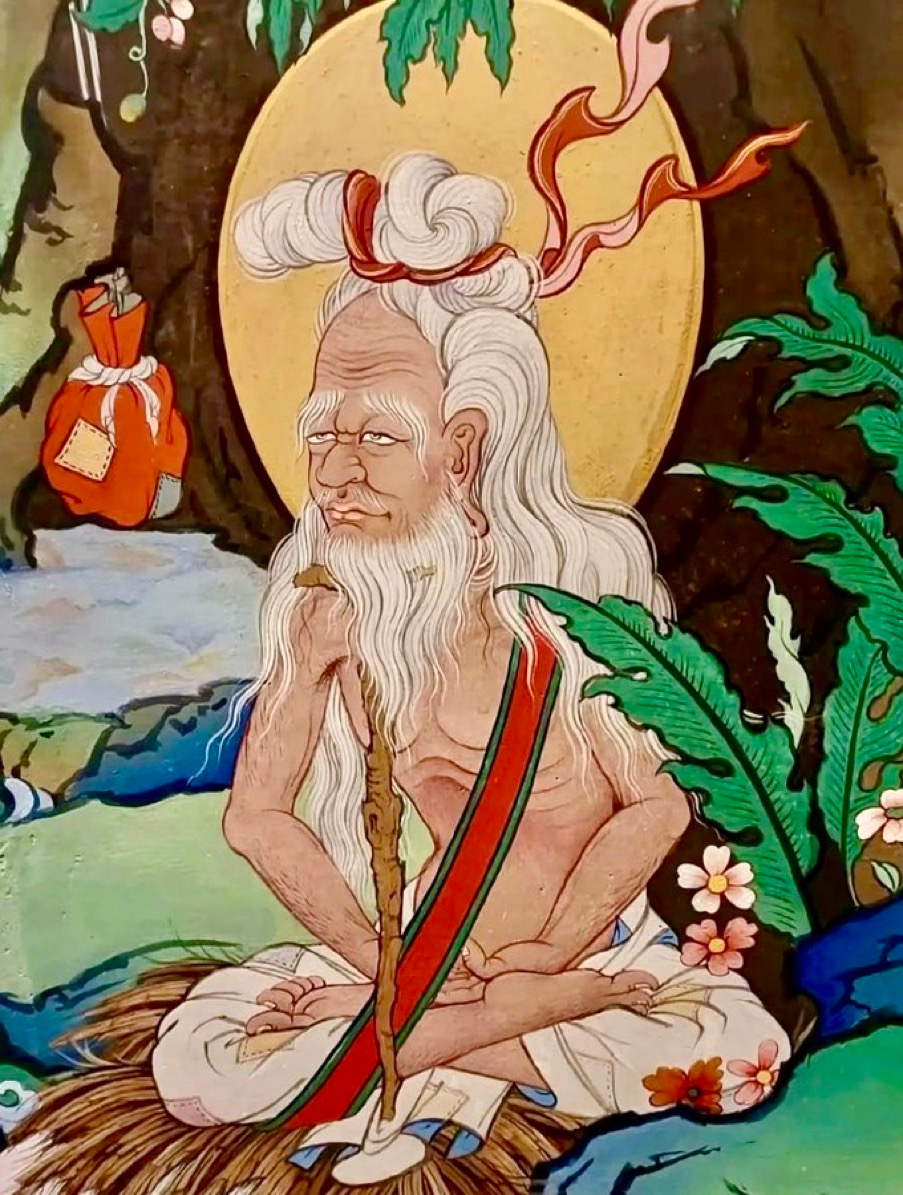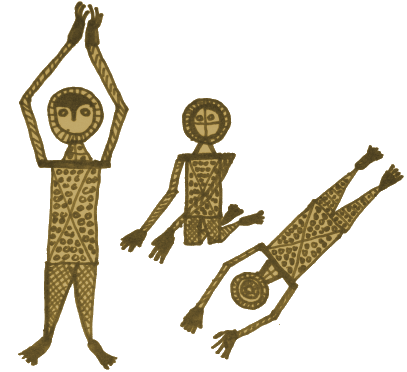2nd
FORTNIGHT of FIRESTAR
As Utilized by the 5 Mt System of Miryai
In the Living Gods, Let the
hallowed Light of Transcendant Truth be praised. Let the Sweet Mystery
of Miryai awaken in the heart of hearts.
FORTNIGHT OVERVIEW
First 5 Day KoDay
1-5 of 2nd Fortnight
Festival & Fast: Nyamalung like Festival on first day.
Practices: Wind related practices. (daily 20" exercise)
History: Shakta, rooted in the Indus Valley
Civilization (3300–1300 BCE), reflects early ShivaShakti worship, evidenced
by seals like the Pashupati figure, predating Vedic traditions. Practices
such as pranayama and wind horse visualizations harness breath and energy
to unite opposites (malefemale, yinyang), fostering devotion. Its unique
idea of creation as a divine union of polarities shaped later Tantric traditions.
Mythos: Yeshey Tzogyal, first female Buddha of Tibet & Padmasambhava/Shenrab
Miwo. Fortnight 2: Trials and Transformation
|
Fortnight Day 1
|
Fortnight Day 2
|
Fortnight Day 3
|
Fortnight Day 4
|
Fortnight Day 5
|
| Feast/Fast |
Nyamalung Festival |
- |
- |
- |
- |
| Practice |
Sang Chöd Smoke Offering (Bön) Sang Chöd is a
Bön ritual where aromatic substances like juniper are burned to purify
and offer to spirits. Light a small fire or incense, chanting mantras to
invoke the fire element’s cleansing power. Visualize the smoke as radiant
light, harmonizing environmental energies. This shamanistic practice uses
fire’s transformative heat to connect with nature spirits, central to Bön’s
worldview. |
Sacred Thread Offering (Shakta): Tie red or yellow threads on wooden
stakes during Devi puja, letting the wind carry vows of devotion to the
goddess. |
Prayer Wheel Spinning (Tibetan Buddhist): Spin wooden prayer wheels
filled with mantras, releasing their blessings into the air to benefit
all beings. |
Wooden Mala Breath Counting (Tibetan Buddhist): Use a wooden mala to
count breaths or mantras, aligning each bead with an exhale to deepen mindfulness. |
Mantra Chanting with Breath (Tibetan Buddhist): Chant OM MANI PADME
HUM while focusing on breath, visualizing compassion spreading through
the air during circumambulation of stupas. |
| History |
Shakta |
Shakta |
Shakta |
Shakta |
Shakta |
| Mythos of Yeshe Tzogyal |
Flight from Marriage: At sixteen, she flees
an arranged betrothal, seeking freedom to pursue her spiritual calling. |
Flight from Marriage: At sixteen, she flees an
arranged betrothal, seeking freedom to pursue her spiritual calling. |
Flight from Marriage: At sixteen, she flees an
arranged betrothal, seeking freedom to pursue her spiritual calling. |
Flight from Marriage: At sixteen, she flees an
arranged betrothal, seeking freedom to pursue her spiritual calling. |
Flight from Marriage: At sixteen, she flees an
arranged betrothal, seeking freedom to pursue her spiritual calling. |
Second 5 Day Ko Day
6-10 of 2nd Fortnight
Festival & Fast: none
Practices: Wind related practices. (daily 20" exercise)
History: Jainism, codified by Mahavira
(599–527 BCE), builds on a lineage of 24 Tirthankaras, with roots possibly
in the 9th century BCE via Parshvanatha. The five vows (ahimsa, satya,
asteya, brahmacharya, aparigraha) and meditation cultivate nonviolence
and detachment, aligning inner purity with outer action. Its distinctive
belief in absolute nonharm and soul liberation predates and parallels Buddhism.
Mythos: Yeshey Tzogyal, first female Buddha of Tibet & Padmasambhava/Shenrab
Miwo.Fortnight 2: Trials and Transformation
|
Fortnight Day 6
|
Fortnight Day 7
|
Fortnight Day 8
|
Fortnight Day 9
|
Fortnight Day 10
|
| Feast/Fast |
- |
- |
- |
- |
- |
| Practice |
Lungta Prayer Flags (Tibetan Buddhist): String colorful prayer flags
inscribed with mantras on wooden poles or across high places. The wind
carries prayers for peace and prosperity, harmonizing the environment.
Five-Element Flag Meditation (Bön/Tibetan): Tie five-colored flags
to wooden stakes or trees, meditating on the air element (green flag) to
balance energies and cultivate clarity. |
Movement Meditation - Dance or movement to embody the flow of
air. |
Pranayama - Breathing exercises to control life force (prana).
Pranayama for Shakti (Shakta): Practice alternate nostril breathing
(Nadi Shodhana) to channel divine energy, invoking the goddess Shakti as
the breath awakens inner vitality. |
Tsa Lung Visualization (Bön)
Tsa Lung is a Bön practice involving breath and energy
channels to cultivate inner heat. In this exercise, you visualize a radiant
fire at the navel chakra, connecting to the fire element. As you inhale
deeply, imagine the fire growing, purifying blockages in the energy channels
(tsa). Exhale, spreading warmth and light throughout your body. This practice
enhances vitality and aligns with the Bön view of fire as a transformative
force, often performed in a seated meditation posture. |
Breath Offering Ritual (Shakta): During puja, offer each exhale as
a surrender to Shakti, visualizing breath merging with cosmic air to unite
with the divine feminine. |
| History |
Jainism |
Jainism |
Jainism |
Jainism |
Jainism |
| MytMythos of Yeshe Tzogyalhos |
Trauma and Resilience: Captured and violated
by suitors, she endures suffering but vows to transform pain into wisdom. |
Trauma and Resilience: Captured and violated
by suitors, she endures suffering but vows to transform pain into wisdom. |
Trauma and Resilience: Captured and violated
by suitors, she endures suffering but vows to transform pain into wisdom. |
Trauma and Resilience: Captured and violated
by suitors, she endures suffering but vows to transform pain into wisdom. |
Trauma and Resilience: Captured and violated
by suitors, she endures suffering but vows to transform pain into wisdom. |
Third 4/5 Day KoDay
11-15 of 2nd Fortnight
Festival & Fast: Nyungne 2 day fast on last two days of fortnight.
Practices: Wind related practices. (daily 20" exercise)
History: Sikhism, founded by Guru Nanak (1469–1539
CE), evolved through ten Gurus, culminating in the Guru Granth Sahib (1604
CE). Practices like langar (community meals) and kirtan (devotional singing)
emphasize service and equality, grounding spirituality in daily life. Its
unique monotheistic vision—Ik Onkar (One Supreme Reality)—rejects caste
and ritualism, offering a direct path to divine unity.
Mythos: Yeshey Tzogyal, first female Buddha of Tibet & Padmasambhava/Shenrab
Miwo.Fortnight 2: Trials and Transformation
|
Fortnight Day 11
|
Fortnight Day 12
|
Fortnight Day 13
|
Fortnight Day 14
|
Fortnight Day 15
|
| Feast/Fast |
- |
- |
- |
Nyungne Fast |
Nyungne Fast |
| Practice |
Sky Gazing with Breath (Bön): Practice Dzogchen sky gazing, syncing
breath with the wind’s movement to dissolve ego and merge with boundless
awareness. |
Ninefold Purification Breathing (Bön) A foundational Bön
practice, this breathing exercise incorporates fire imagery to cleanse
the subtle body. Sit cross-legged and visualize three channels in your
body. Inhale deeply, imagining fiery light entering the central channel,
burning away negative emotions like anger or attachment. Exhale impurities
as dark smoke. Perform nine breaths, focusing on the heat and light purifying
your mind and body, fostering clarity. |
Breath Meditation on Air (Tibetan Buddhist): Sit in meditation, focusing
on the sensation of breath as the air element, fostering spacious awareness
and connection to the divine. |
Flower Offering to Wind (Shakta): Offer jasmine or marigold flowers
at an outdoor altar, allowing the breeze to carry their fragrance as a
prayer to the goddess. |
Wind Horse Visualization (Tibetan Buddhist): Meditate on the lungta
(wind horse), imagining it galloping through the air, carrying your aspirations
for spiritual strength. |
| History |
Sikhism |
Sikhism |
Sikhism |
Sikhism |
Sikhism |
| Mythos of Yeshe Tzogyal |
Royal Marriage: Given to King Trisong Detsen
as a consort, she uses her position to foster Buddhism in the court. |
Royal Marriage: Given to King Trisong Detsen
as a consort, she uses her position to foster Buddhism in the court. |
Royal Marriage: Given to King Trisong Detsen
as a consort, she uses her position to foster Buddhism in the court. |
-Royal Marriage: Given to King Trisong Detsen
as a consort, she uses her position to foster Buddhism in the court. |
Royal Marriage: Given to King Trisong Detsen
as a consort, she uses her position to foster Buddhism in the court. |
OTHER DAILY PRACTICE EXAMPLES
To be Personalized by AI
Preliminary Stage (Wood)
1. Refuge Tree Visualization
Purpose: Establish a foundation for liberation
by taking refuge in the Three Jewels.
How to Accomplish: Sit cross-legged, hands in
prayer mudra (body). Recite a single refuge vow, “I take refuge in Buddha,
Dharma, Sangha” (speech). Visualize a radiant tree with the Three Jewels
at its canopy, roots grounding you in aspiration (mind). Practice daily
for 15 minutes.
2. Prostration to Padmasambhava
Purpose: Purify physical and mental obstacles
through devotion.
How to Accomplish: Perform 21 full prostrations,
bowing to an image of Padmasambhava (body). Say, “I purify through devotion”
(speech). Visualize your negativities dissolving into the earth, vitality
rising like sap (mind). Practice daily.
3. Aspiration Offering of Flowers
Purpose: Accumulate merit by offering vitality
to all beings.
How to Accomplish: Place fresh flowers on an
altar (body). Declare, “I offer vitality for liberation” (speech). Visualize
flowers multiplying, their fragrance uplifting all sentient beings (mind).
Perform weekly.
4. Lung Sang (Wind Purification)
Purpose: Cleanse subtle energy channels to enhance
spiritual growth.
How to Accomplish: Sit and breathe deeply, focusing
on air entering nostrils (body). Say, “My channels are purified” (speech).
Visualize breath as green wind clearing blockages, expanding vitality (mind).
Practice daily for 10 minutes.
5. Yeshe Tsogyal Aspiration Practice
Purpose: Cultivate bodhicitta by invoking Yeshe
Tsogyal’s compassionate energy.
How to Accomplish: Sit with an image of Yeshe
Tsogyal, hands on knees (body). Recite, “May I awaken like Tsogyal for
all” (speech). Visualize her radiant form blessing your aspiration to grow
for others’ benefit (mind). Practice daily.
Transformative Stage (Mother Lineage) (Wood)
1. Deity Yoga of Green Tara
Purpose: Transform self-perception by embodying
Tara’s vital compassion.
How to Accomplish: Sit in lotus posture, hands
in Tara’s mudra (body). Say, “I am Tara’s vitality” (speech). Visualize
yourself as Green Tara, green light radiating to heal relationships, inspired
by Yeshe Tsogyal’s compassionate energy (mind). Practice daily for 20 minutes,
no mantra.
2. Chöd of Attachment (Bön-Inspired)
Purpose: Cut through relational clinging to cultivate
boundless vitality.
How to Accomplish: Sit in a natural setting,
gesturing to offer your body to demons (body). Declare, “I release attachment
for all” (speech). Visualize your form as green wind, shared with all beings,
dissolving self-other boundaries (mind). Practice weekly, no initiation
needed.
3. Subtle Body Prana Flow
Purpose: Transform relational energy by channeling
vital prana.
How to Accomplish: Stand, moving arms to direct
breath-energy (body). Say, “Prana unites us” (speech). Visualize green
prana flowing from your heart to a person, harmonizing your connection
(mind). Practice daily for a specific relationship.
4. Yeshe Tsogyal Partner Visualization
Purpose: Transform intimate relationships by
invoking Tsogyal’s wisdom.
How to Accomplish: Sit facing a partner’s image,
hands in offering mudra (body). Affirm, “We awaken as Tsogyal” (speech).
Visualize you and the partner as Tsogyal and Padmasambhava, green light
merging your energies (mind). Practice daily, no mantra.
5. Vitality Offering Ritual
Purpose: Transform environmental relationships
by offering life-force.
How to Accomplish: Place a green plant on an
altar or in nature (body). Say, “I offer vitality to the world” (speech).
Visualize the plant’s energy expanding, connecting all beings in a web
of growth (mind). Perform weekly.
Dzogchen Final Stage (Wood)
1. Trekchö of Vital Presence
Purpose: Rest in rigpa as boundless vital awareness.
How to Accomplish: Sit in nature, eyes open,
body relaxed (body). Say, “I am vital rigpa” (speech). Rest in open awareness,
phenomena arising as vibrant prana, cutting through concepts (mind). Practice
daily for 20 minutes.
2. Spontaneous Growth Rest
Purpose: Embody non-dual presence in relational
contexts.
How to Accomplish: Stand naturally, feeling breath
(body). Affirm, “All is vital presence” (speech). Rest in rigpa, seeing
relationships as spontaneous expressions of awareness (mind). Practice
during interactions.
3. Dissolving into Prana
Purpose: Merge with the natural state through
vital dissolution.
How to Accomplish: Lie in a forest, feeling air
on skin (body). Whisper, “I dissolve into prana” (speech). Visualize your
form as green wind, merging with boundless rigpa (mind). Practice weekly.
4. Yeshe Tsogyal’s Pure Vision
Purpose: Realize phenomena as vibrant emptiness
with Tsogyal’s blessing.
How to Accomplish: Gaze at the sky, softening
focus (body). Say, “Tsogyal reveals pure vitality” (speech). Rest in rigpa,
seeing all as Tsogyal’s radiant awareness (mind). Practice for 15 minutes
daily.
5. Compassionate Vitality Rest
Purpose: Radiate compassion from the natural
state.
How to Accomplish: Sit relaxed, hands open (body).
Say, “Compassion grows freely” (speech). Rest in rigpa, letting Tsogyal’s
compassionate vitality radiate effortlessly (mind). Practice for 20 minutes
daily.
Yesai the Nazorean 2021 - All
Rights Reserved



![]() Feast/Apr
11: The male-female, yin-yang side of creation. The perception of two distinct
expressions or characters of existence. Shiva & Shakta union.
Acknowledging the union of opposites in natural phenomenon, human conception,
and metaphysical practice. Devotional; worship. Feeding people. Courage
as warriors. (Celibacy as a deviation away from this reality.) . The oldest
strata of Shiva and Shakti worship is associated with the first 5 day period
of the 2nd Fortnight, The Jains and their 5 Jain Vows with the 2nd, and
the Sikhs with the last third of the 2nd Fortnight.
Feast/Apr
11: The male-female, yin-yang side of creation. The perception of two distinct
expressions or characters of existence. Shiva & Shakta union.
Acknowledging the union of opposites in natural phenomenon, human conception,
and metaphysical practice. Devotional; worship. Feeding people. Courage
as warriors. (Celibacy as a deviation away from this reality.) . The oldest
strata of Shiva and Shakti worship is associated with the first 5 day period
of the 2nd Fortnight, The Jains and their 5 Jain Vows with the 2nd, and
the Sikhs with the last third of the 2nd Fortnight.
